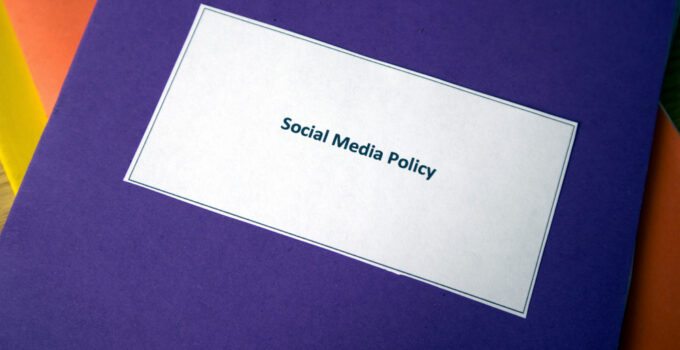A social media policy is a beneficial document for businesses of all sizes. It’s a vital tool that helps maintain your online brand identity, protect your company from legal difficulties, and make sure that your employees represent your business correctly on social media.
In this article, company formation agent, Rapid Formations, explains what a social media policy is and how business owners can create one. They’ll highlight the key components of a social media policy, their purpose, and how to implement a the policy in the workplace.
What is a social media policy?
It’s policy is a set of guidelines explaining how your brand and employees behave on social media. You can have a business or personal social media policy, or both.
A business social media policy applies to your company. It determines your company’s tone of voice and brand identity. More specifically, it clarifies how your social posts should be constructed and how your brand communicates with its followers and customers on different social media channels.
Meanwhile, a personal social media policy applies to your employees and their conduct on their personal profiles. You may create a personal social media policy to ensure that your team’s online activity aligns with your business image and represents your company correctly.
The purpose of a social media policy is, fundamentally, to maintain brand consistency, reduce security risk for your business and employees, and establish a proactive strategy to mitigate public relations (PR) disasters.
How to create a social media policy
Your social media policy can be part of your overall brand guidelines or a standalone policy. Here are the key components of a social media policy that your document should include:
Best practices
A comprehensive social media policy should demonstrate the best practices and appropriate social media etiquette that your company and its employees must adhere to. Include as many guidelines as necessary, such as:
- Use respectful language
- Do not reveal any confidential company information
- Protect clients’ and readers’ privacy
- Respond to comments in a timely manner
This section should also describe the process employees are to follow when someone interacts with your company on social media. This can be anything from a customer asking a question about their order, for example, or a follower leaving a comment on a post. Here, it’s useful to outline details such as the correct tone of voice and language to use when responding.
Another important area to cover in this part of your social media policy is how employees should deal with questionable content. For instance, if they encounter any misinformation or a news leak about your company, explain how they should reply, who they should inform within the company, and who the main point of contact is (e.g. your social media manager).
Your best practices should be as detailed as possible. However, remember that if you own a small or micro business, your social media policy won’t be very long. It’s important to update it as your company grows but in the first instance, summarise your key best practices for a simple and effective social media policy.
Copyright rules

This is a major part of your social media policy. When posting images and videos, your staff should be fully trained on copyright rules to avoid any legal difficulties.
Your copyright rules should explain how original as well as third-party content is to be used. For example, if you share licensed images, you’ll need to buy the copyright or receive permission from the owner to use their content. When doing so, you must also credit the image or video in the social media post.
Another example is to ensure that you obtain any participants’ permission in your original content before it is released on social media. Don’t forget that these rules go both ways and your company’s own content is also at risk of being misused by others.
For lawful social media content usage, this part of your social media policy should be constructed with your legal team. They should create a clear social media governance process that’s easy for everyone in the organisation to understand.
Finally, be sure to include details on what employees should do in the event of copyright infringement, including where and how to report it. For more guidance on digital copyright, visit the gov.uk website.
Personal social media use
Your employees are likely to have personal social media accounts. While you can’t control what they share in their own time, your social media policy can set out guidelines on how they should interact with the company and its online content.
The idea is that your team members represent your company, so there might be certain rules that you’d like them to follow to uphold your brand’s reputation.
In this part of your social media policy, you may want to answer questions like:
- Can staff share company information in their social media bios?
- Can employees post images of the workplace/workwear on their personal social media pages?
- When commenting on a company post, should they use a certain tone or language?
- Should employees have separate social media accounts for business and personal use?
Even if your company doesn’t have a social media presence, it’s worth having a social media policy for the purpose of personal use guidelines.
Security and privacy
One of the main objectives of having a social media policy in place is to minimise security and privacy breaches. Being active on social media means you could be at risk of phishing and hacking attacks, which could jeopardise your company’s and employees’ sensitive information.
To keep your business secure and your team safe online, your social media guidelines should cover the following details:
- Rules around sharing confidential information (company or personal) on social media
- Sharing or engaging with inflammatory content
- How to keep social media accounts and digital devices secure
- Keeping software and apps up-to-date
You should work with your IT and legal teams to create thorough and compliant security and privacy guidelines for your social media policy. They should advise how to create safe social media passwords, how to spot social media hacking attempts, and the correct protocol in the event of a security breach.
How to respond to emergencies
PR disasters are not uncommon. They can happen to the smallest of companies and they can be considerably damaging if unmanaged. So, it’s essential to determine how you plan to handle social media emergencies to ensure the smoothest possible outcome.
The good news is that if you do encounter a PR disaster, its effects can be significantly mitigated with a solid action plan. Start by identifying the key stakeholders and the roles they play in an emergency. Perhaps your head of marketing should delete a damaging post, or perhaps you, as the business owner, should post an apologetic statement.
Whichever way works best for your business, have a response team ready to go, ensuring that everyone is properly briefed on their responsibilities in the event of a PR crisis. That way, if it does come to that, you can do your best to minimise its long-term effects and restore your company’s reputation quickly and efficiently.
Naturally, it’s impossible to prepare for every scenario, so you should also create guidelines on how to approach unforeseen issues as and when they happen. Determine details such as who reviews and approves social media updates, who handles customer support queries, and who is responsible for fact-checking information.
Disciplinary process
While there is no obligation for staff to formally sign a social media policy, it should be clearly expressed that they are subject to it as an employee and there is a disciplinary process for breaking these rules.
Remember that a part of your social media policy (the copyright rules section) is a lawful requirement, which can have serious consequences if breached. So, every member of staff – from intern to CEO – should ensure that they adhere to the guidelines.
When establishing the disciplinary process, it’s important to be clear, fair, and consistent. The same rule(s) and treatment should apply to every staff member.
Other considerations
On top of the above essentials, other common social media policy components that you may want to include are:
- Purpose – Outline the purpose of the policy and who it applies to.
- Social media platform overview – Clarify which social channel(s) the policy applies to and whether the rules are different for each one.
- An approval process – Who signs off every social media post?
- Examples – Including good and bad examples of your policies can help people understand the rules and boundaries.
- Influencer guidelines – Social media protocol if you work with online influencers
- Document review – Explain when and how often the policy will be reviewed and updated.
To help you get started, you can find a simple and customisable social media policy template on the Hootsuite website.
How to implement a social media policy

Source: shrm.org
When creating your social media policy, you should work with your key stakeholders to produce a clear and concise document that everyone can easily understand. Seek input from the marketing and social media teams as well as HR, IT, and legal departments.
You may also find it useful to consult team leads or other employees to raise any points that may have previously been missed. Once you’ve created your social media policy, it should be distributed to everyone in the company and kept in a central and easily accessible place.
It’s also a good idea to make it a mandatory read, ensuring that everyone has familiarised themselves with the guidelines. Also, appoint someone to answer people’s questions about your new social media policy.
Finally, make sure that your social media policy is reviewed, updated, and re-distributed regularly.
Summary
A social media policy is a rulebook on your company’s and employee’s online conduct. It covers key areas like tone of voice, copyright rules, and security and privacy provisions. Other common components include the content approval process and disciplinary action for breach of policy.
The main objectives of a social media policy are to maintain a consistent brand image, protect your business and staff from legal complications, and help you prepare for a possible PR emergency.






